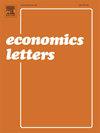供需模型的有向无环图表示
IF 1.8
4区 经济学
Q2 ECONOMICS
引用次数: 0
摘要
这篇笔记展示了如何用有向无环图来表示传统的供需模型。它探讨了计量经济学术语和因果推理术语之间的关系,说明这两个框架是完全一致的。本文章由计算机程序翻译,如有差异,请以英文原文为准。
Directed acyclic graph representation of the demand–Supply model
This note shows how the traditional demand–supply model can be represented using a Directed Acyclic Graph. It explores the relationship between econometrics terminology and causal inference terminology, illustrating that the two frameworks are entirely consistent with each other.
求助全文
通过发布文献求助,成功后即可免费获取论文全文。
去求助
来源期刊

Economics Letters
ECONOMICS-
CiteScore
3.20
自引率
5.00%
发文量
348
审稿时长
30 days
期刊介绍:
Many economists today are concerned by the proliferation of journals and the concomitant labyrinth of research to be conquered in order to reach the specific information they require. To combat this tendency, Economics Letters has been conceived and designed outside the realm of the traditional economics journal. As a Letters Journal, it consists of concise communications (letters) that provide a means of rapid and efficient dissemination of new results, models and methods in all fields of economic research.
 求助内容:
求助内容: 应助结果提醒方式:
应助结果提醒方式:


